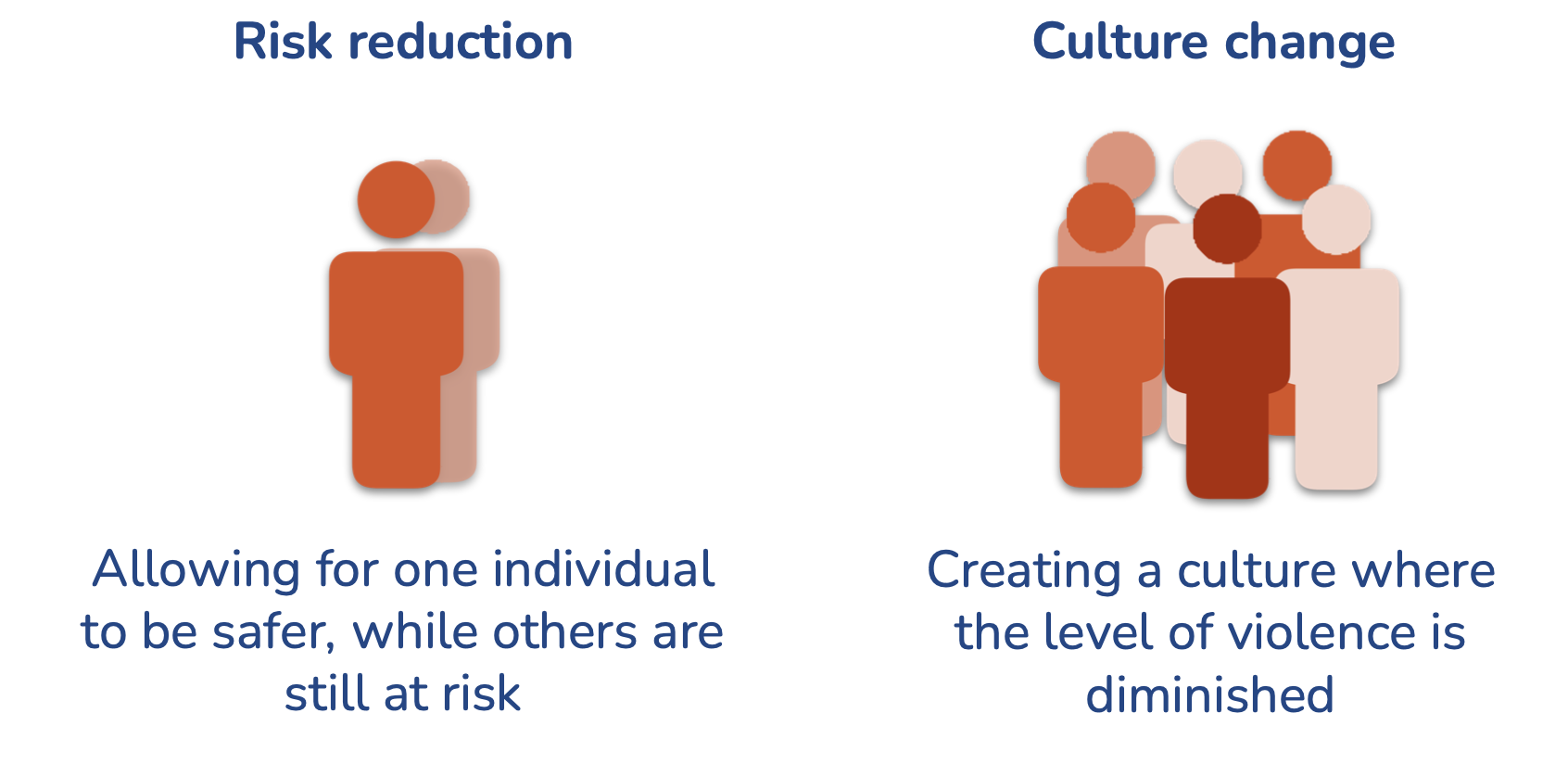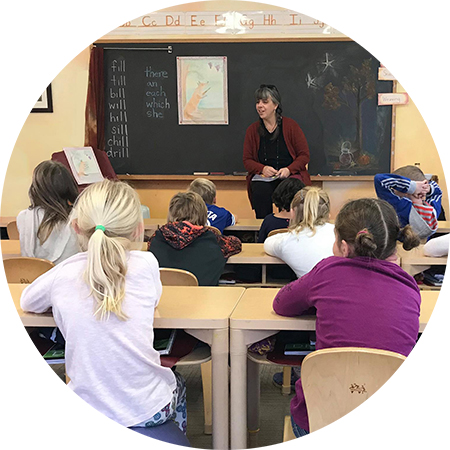Prevention
Sexual violence is a public health crisis affecting school-age children at epidemic rates:
1 in every 2 transgender and non-binary youths, 1 in 4 female youths, and 1 in 6 male youths will be sexually assaulted before they turn 18.
Care for these survivors is crucial, but care is not enough.
As a result we have partnered with students, teachers, parents and the general community to start changing the attitudes and behaviors that put them at risk.
What began in 2009 as single-class presentations on sexual violence prevention in high school health classes is now a cohesive, comprehensive program designed to influence a 13-year span of children’s development.
Our classes aim to make students aware and active shapers of their own culture, teaching them how to step forward and interrupt unhealthy behaviors – and how to create healthier ones. Just as crucially, the program teaches staff, administrators and parents how to help.
Ours is currently the only classroom-based sexual violence prevention program in Jackson County. We are thus enabling area schools to fulfill the 2015 state mandate that each school adopt a comprehensive child sexual abuse prevention curriculum (Senate Bill 856 [i]). To date we have implemented all or parts of our K-12 curriculum in Ashland, Phoenix/Talent, Medford, Butte Falls, and Central Point.
Continue reading for more information about our approach, philosophy and a detailed list of our K-12 curriculum as well as further resources. Thank you to Claire Harkola for their contribution to the content. If you’d like more information, contact Kyndra Laughery: kyndra@jacksoncountysart.org.
What is Prevention
Primary prevention is the health term for intervening before a health effect occurs. Our goal with primary prevention is about preventing the violence before it occurs. It’s a framework that focuses on how we can change our culture to lower rates of harm.
We focus on behaviors and beliefs ingrained in our culture that allows violence to keep happening. The more we understand how social norms, societal attitudes, and dynamics of power impact sexual and gender-based violence, the more we can lower rates of harm and see real change in our communities.
 Another framework, risk reduction, focuses on “how not to get assaulted” through recommending that people employ strategies to keep themselves safe such as taking self-defense classes, carrying pepper spray, or keeping your hand over your cup at all times. These are all things that can be helpful in keeping individuals safe and we encourage folks to do what helps them feel safe, but there needs to be more conversation.
Another framework, risk reduction, focuses on “how not to get assaulted” through recommending that people employ strategies to keep themselves safe such as taking self-defense classes, carrying pepper spray, or keeping your hand over your cup at all times. These are all things that can be helpful in keeping individuals safe and we encourage folks to do what helps them feel safe, but there needs to be more conversation.
Along with risk reduction efforts we need to look at the things in our culture that allow these levels of violence to continue. We believe that we can create a world where the risks are reduced for everyone through preventing violence from happening in the first place.
Through our K-12 prevention lessons, community education, parent nights, work with teachers and administrators, and inter-organizational collaborations our main goal is change, creating an environment where consent, communication, and accountability are the norm and every person’s bodily autonomy is respected and valued.
Click here to read more about violence prevention.
To learn more, listen to our JPR interview, “Teaching Sex Assault Prevention in School.”
Our Philosophy
The Jackson County SART prevention program aims to work through a Prevention Through Liberation (PTL) lens. PTL asks us to look at ways we can create communities of support and safety for all people regardless of their identity.
“Prevention and liberation are both actions: the action of stopping something from happening, and the action of setting someone free. Thus Prevention Through Liberation, at its roots, is about setting people – and societies – free through stopping sexual and domestic violence and promoting sexual and relational health. Alternately, Prevention Through Liberation is about stopping domestic and sexual violence through setting people free from oppression. It works both ways.
Anti-oppression work IS primary prevention of sexual and domestic violence. Any work that counters oppression contributes to a decrease in such violence, and a corresponding increase in sexual health and relationship wellbeing. ”
—Choya Adkison-Stevens and Vanessa Timmons, Oregon Coalition Against Domestic & Sexual Violence (OCADSV)
Read more about OCADSV’s PTL theory here.
How we put it all together
- Education: Youth, teachers/staff, parents, community members, businesses, health care professionals;
- Community Partnerships: Working in collaboration with community partners, participating on local and state-wide workgroups and coalitions, supporting the work of other organizations working to reduce violence in our communities;
- Equity: A commitment to anti-oppression work through our research, curriculum, and continued education.
Our K-12 Curriculum
We use stories and scenarios to explore the different topics we bring to the classroom.
Our lessons are delivered in a way that empowers children to speak up and seek help if something happens to them or someone they know. We understand some of the topics will seem a little scary to think about, but we make sure to talk to kids about the purpose of our lessons before we deliver them. We talk about how this is another safety conversation they have at school, like fire drills or lock down drills. Things that can be scary to think about but important so we know what to do if they ever happen.
We end each lesson having children get up and move, take some breaths, and think about the adults in their lives that they feel safe and comfortable around. We acknowledge the heaviness of the conversation and encourage them to shake off any tension or discomfort that came up, and check in with their trusted adults if they feel like they need to.
Our goal is to provide resources for parents to understand and support the conversations at home. Click the links below for details on our K-12 curriculum and access to our parent portal.
Coalitions
Oregon SATF (Sexual Assault Task Force)
OCADSV (Oregon Coalition Against Domestic and Sexual Violence)
FAQs
Where can I get the books that SART reads in the classes?
A list of the books that we read and where to purchase them can be found here. SART is also working toward getting all of the books that we read into the schools’ libraries for students to check out. Please reach out to us at jcsart@charter.net if you would like to request a copy of one of these books.
What qualifications do the Prevention Educators have to teach this material?
All SART employees are required to complete at least 40 hours of training in advocacy for victims of domestic violence, sexual assault, or stalking that meets the minimum training requirements set out in OAR 137-085-0080.
Our Prevention Educators have extensive experience working with youth and are actively involved in the Oregon State Coalition meetings with other prevention organizations throughout the state.
SART also offers continuing education opportunities in the form of workshops, webinars, state-wide conferences, and more. This is to ensure that our Prevention Educators are implementing best practices and have the most accurate, up to date, effective strategies to present this material.
What are some supplemental materials I can use to continue this conversation at home?
SART has a list of suggested materials that caregivers can use to continue these conversations with their students here on our family resources page. There are books and videos to check out here on our K-12 curriculum page as well. Please reach out to us at jcsart@charter.net if you have other suggestions that are not on this list or if you would like to request a copy of one of these materials.
What happens if a Prevention Educator receives a disclosure of abuse from a student during one of their classes?
The procedure for navigating disclosures of abuse varies depending on the age of the person who’s disclosing.
If a disclosure is made by a young person who is age 14 or under, we make sure that they have the proper safety measures and support people are in place, whether that be a teacher, staff person, caregiver, or other trusted adult. It is SART’s priority to ensure the safety of the young people we connect with, and we are always sure to assess safety and act accordingly.
If the student making this disclosure is over 15 years of age, SART staff are unable to report this disclosure due to the legal privilege associated with confidential advocacy. SART staff then refers the young person to appropriate resources, including our Resource Specialist, support groups, or individual advocacy.
To find out more about confidentiality and legal privilege, visit this webpage from the Oregon Coalition Against Domestic and Sexual Violence (OCADSV).
Common Concerns
I don’t know the people coming into my child’s classroom to present this material. What qualifications do the Prevention Educators have to teach this material?
All SART employees are required to complete at least 40 hours of training in advocacy for victims of domestic violence, sexual assault, or stalking that meets the minimum training requirements set out in OAR 137-085-0080.
Our Prevention Educators have extensive experience working with youth and are actively involved in the Oregon State Coalition meetings with other prevention organizations throughout the state.
SART also offers continuing education opportunities in the form of workshops, webinars, state-wide conferences, and more. This is to ensure that our Prevention Educators are implementing best practices and have the most accurate, up to date, effective strategies to present this material.
I want to make sure that what my student learns about is in accordance with our family belief system. Are the Prevention Educators teaching my kids about gender identity, sexuality, or LGBTQIA+ topics in the classroom?
Anti-oppression, equity and inclusion programming is violence prevention work. Because of this, SART’s prevention education includes discussions of the dynamics at play that allow someone to harm another person, including the oppression and marginalization of various communities. While these discussions do include conversations about gender identity, sexuality, and other LGBTQIA+ topics, SART does not influence or push any identity onto any individual.
SART recognizes that individual experiences vary depending on the individual’s intersecting identities, and we validate and celebrate everyone’s truth, identity, and lived experience. Our message is simply that no one has the right to harm another person, regardless of their beliefs, identity, or dynamics at play.
Caregivers are also welcome to opt their child out of attending this class if they prefer their student not participate in these conversations.
I feel that these are conversations that should happen in the home and not in the classroom.
Both home and school are appropriate places for students to be taught about their right to bodily autonomy, the importance of consent, respecting differences, and protecting each other from violence. Schools are ethically and legally obligated to protect their students from harassment. Teaching students about sexual violence in schools is a step toward further offering this protection.
In addition to this, many families do not know how to have these conversations with their children, and many cases of child abuse are unfortunately taking place within the home itself. Offering this knowledge in the classroom gives every student the opportunity to learn that their body belongs to them and that no one ever has the right to cause them harm.
We encourage caregivers and families to continue these conversations at home with their children, and SART offers resources to do so. This is an ongoing dialogue as children grow and mature, and it is hugely beneficial for young people to hear this information from someone who they know and trust.
Caregivers are also welcome to opt their child out of attending this class if they prefer their student not participate in these conversations at school.
I worry that my child will be scared hearing about this topic and think that something bad will happen to them.
SART understands that some of the topics will seem a little scary to think about, but we make sure to talk to kids about the purpose of our lessons before we deliver them. We talk about how this is another safety conversation they have at school, just like fire drills or lock down drills. It doesn’t mean that these things will absolutely happen, but it’s important to be prepared for them just in case they do. These are things that can be scary to think about, but they’re important to talk about so we know what to do if they ever happen. We don’t need to be scared when we’re prepared.
We end each lesson having children get up and move, take some breaths and think about the adults in their lives that they feel safe and comfortable around. We acknowledge the heaviness of the conversation and encourage them to shake off any tension or discomfort that came up and check in with their trusted adults if they feel like they need to.
I want to be aware of what is being taught to my child in their classes. How can caregivers know what you’re talking to their students about?
We encourage caregivers to engage with their child’s learning and be aware of what curriculum they’re being presented with. A complete grade-by-grade breakdown of SART’s K-12 curriculum is fully available here on our Curriculum Resources page of the Prevention Program portion of the website.
We encourage you to look into what information is being presented in each grade and reach out to us with any questions you may have.
I want to be prepared for when you’re coming into my child’s classroom. Will we be notified when you’ll be coming in?
It is standard practice for the child’s teacher or school to send out an announcement for when SART will be attending classes so that caregivers are notified and prepared. This also gives caregivers an opportunity to prepare their child and continue the conversation at home if they choose to do so.
I don’t feel comfortable with my child participating in this conversation at school. Is it mandatory for my child to attend these classes?
While it is mandatory for schools to provide curriculum related to sexual violence prevention in accordance with Senate Bill 856 (Erin’s Law), it is not required that students attend these classes. Caregivers are welcome to opt their child out of attending this class if they prefer their student not participate.
Does your curriculum follow ODE standards?
Our curriculum meets Oregon Health Education Standards and Senate Bill 856 (Erin’s Law) requirements in accordance with the Oregon Department of Education. Please visit our Curriculum Resources page to see a complete list of our K-12 curriculum and the topics we speak to.
I worry that talking about this subject with students will increase rates of harm.
There is no research or data that shows a causal relation between teaching sexual violence prevention and increases in rates of harm.
There does tend to be an uptick in reporting rates of harm at the school directly after SART’s classroom presentations; that being said, increases in reporting does not indicate an increase in frequency.
Many students become aware that what is happening to them is abuse and is not okay, which enables them to talk to an adult that they trust to get the support that they need.
I think these conversations are happening at too young of an age. I don’t feel that kids are ready to have these conversations yet.
People of all ages experience sexual violence, and it’s important that everyone, regardless of their age, has knowledge and information on how to identify abuse and ways of accessing support.
It is never too early for children to learn that their body belongs to them and what they say goes when it comes to what happens to their body and how.
We ensure that all of our curriculum and materials are age-appropriate and are presented in an easily digestible format in accordance with the age and maturity level of the students.
I don’t want my child’s innocence to be taken away by talking about something like this. Kids these days have enough to worry about.
All kids are inherently innocent, regardless of the experiences they’ve been through or the conversations they’ve had. Having a conversation that empowers children to voice what they’re comfortable with happening to their body and when, will not make that child any less wide-eyed and ingenuous.
These conversations don’t diminish a child’s sense of wonder and innocence, and they ultimately support children who are being harmed to speak up and advocate for themselves and their right to bodily autonomy.
[i]SB 856, Sex Abuse Prevention Instruction. Oregon Department of Education, 2015. Read more here.




